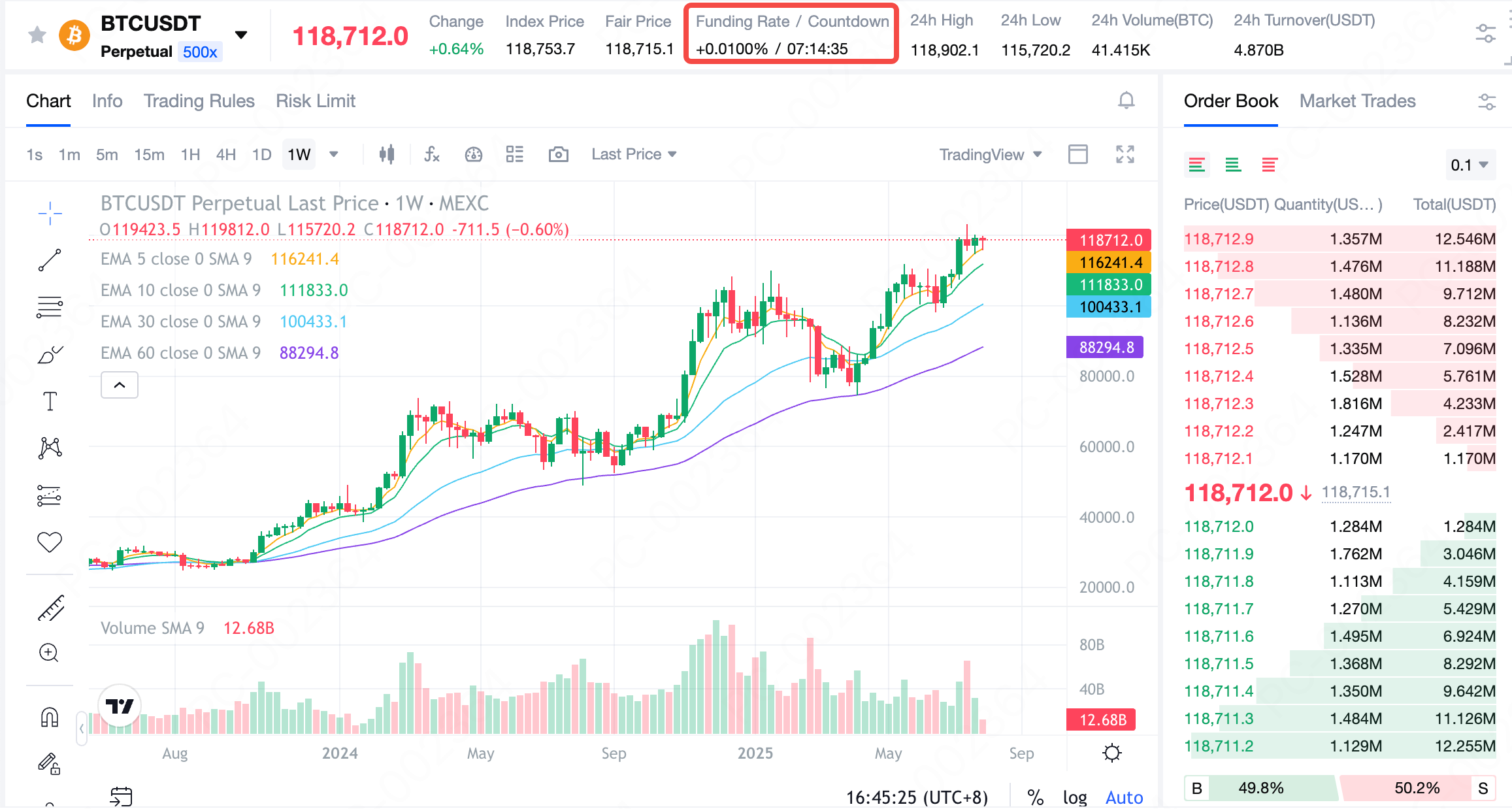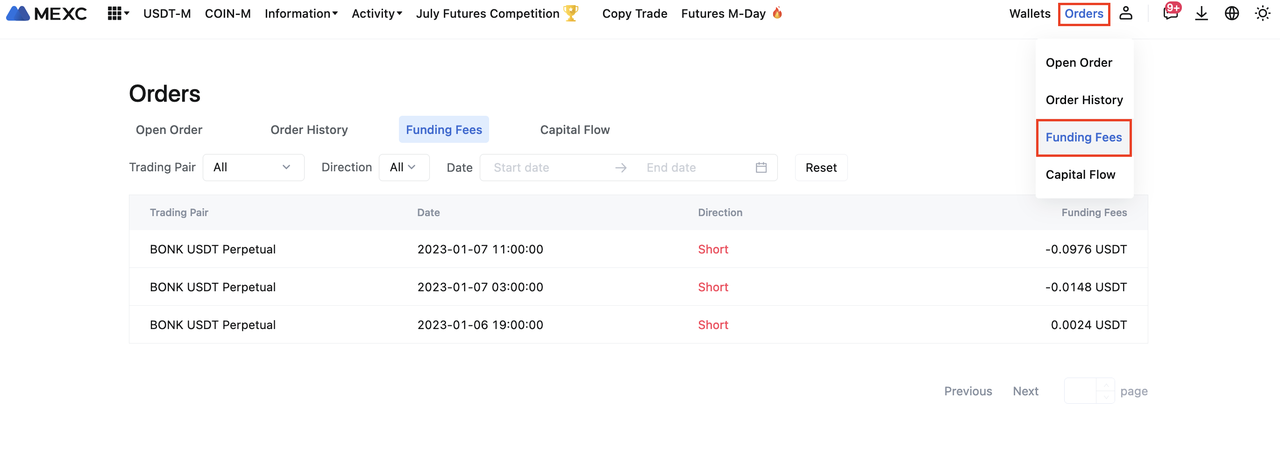MEXC Exchange/Learn/Trading Guide/Futures/Understanding MEXC Funding Rates: Say Goodbye to Hidden Costs in Futures Trading
Understanding MEXC Funding Rates: Say Goodbye to Hidden Costs in Futures Trading
Related Articles

Have you ever experienced this? You predicted the market direction correctly in a futures trade, yet your profits kept shrinking, or your balance mysteriously dropped? The culprit might be something most beginners overlook: the funding rate.
For MEXC’s Perpetual Futures trading, the funding rate is a critical cost variable that often escapes the attention of less experienced traders. In this article, we’ll break down everything you need to know—what it is, how it's calculated, when it’s charged, and how to avoid common pitfalls—so you can finally gain clarity on this "hidden cost."
1. What Are Funding Rates? A Must-Know Mechanism for Every Trader
The funding rate is a mechanism that helps align the price of perpetual futures with spot market prices. It ensures market stability by requiring long and short position holders to periodically pay each other.
Here’s how it works on MEXC Futures:
- When the Futures price is lower than the Spot price, the funding rate is negative, and shorts (sellers) pay longs.
This fee isn’t charged by the platform—it’s paid peer-to-peer between traders—but it can significantly impact your actual returns.
Example
You go long on BTC, and your prediction is correct, but due to a high funding rate, you’re charged every 8 hours. As a result, your profits shrink—or worse, turn into losses. That’s the reality of this “hidden cost.”
*BTN-Trade BTCUSDT&BTNURL=https://www.mexc.com/futures/BTC_USDT*
2. Why Funding Rates Matter
In futures trading, the funding rate isn't just a number. It can influence your profitability, strategy, and even how you interpret market sentiment. Here's why you shouldn't overlook it:
2.1 Keeps Futures Prices Anchored to Spot Prices
Since perpetual futures contracts have no expiry, price deviations from the spot market can persist. Funding rates help fix this by financially incentivizing traders to balance the market.
Example
If BTC spot is $100,000 and the futures price is $101,000 (overpriced):
A positive funding rate is applied. Longs must pay shorts, making it more expensive to go long. This discourages excess buying and pushes the futures price closer to spot.
2.2 Reflects Market Sentiment: Real-Time Signal of Bullish or Bearish Bias
The funding rate reveals whether traders are leaning bullish or bearish—it’s a live indicator of market sentiment.
Example
A funding rate of +0.05% on BTCUSDT means most traders are bullish and going long. Conversely, a rate of -0.03% suggests bearish sentiment, with more traders shorting the market.
In short, the funding rate is like a thermometer for market sentiment.
2.3 Preventing Unilateral Market Positioning
When too many traders pile into the same side (long or short), funding rates automatically adjust to restore balance. Higher rates create natural pressure for overcrowded positions to exit.
Example
If BTC's funding rate spikes to +0.15%, long traders must pay 0.15% every 8 hours—essentially a "penalty" for being part of the crowd. This "crowding tax" encourages some traders to close positions, reducing one-sided pressure and bringing the market back into equilibrium.
2.4 Impact on Net Returns: The Hidden Cost of Directional Trades
Funding rates represent a real cost that can significantly erode profits, even when your market prediction is correct. In extreme scenarios, funding costs can transform profitable trades into losses.
Example
You take a long position on BTC, and the price increases 3% over 24 hours—a successful directional call. However, with funding rates at +0.25% every 8 hours, you pay 0.75% in total funding costs throughout the day. This reduces your net profit to just 2.25%, representing a 25% reduction in returns due to funding alone.
The impact becomes more pronounced in ranging or highly volatile markets, where funding costs can accumulate while price movements remain limited, potentially resulting in net losses despite accurate predictions of market direction.
2.5 Increased Liquidation Risk: Funding Costs Reduce Margin
Funding fees are automatically deducted from your position margin when your account balance is insufficient to cover them. This reduction in available margin moves your liquidation price closer to the current market price, increasing the risk of liquidation.
Example
You open a leveraged long position on BTCUSDT with a comfortable liquidation buffer. As funding fees accumulate over multiple periods, they are automatically deducted from your position margin. This gradual reduction in available margin progressively moves your liquidation price closer to the current market price, shrinking your safety buffer. A market downturn that you could previously withstand now poses a significantly higher liquidation risk.
3. How Is the Funding Fee Calculated?
MEXC offers two types of futures: USDT-M Futures and Coin-M Futures. Their funding rate calculations differ slightly.
3.1 USDT-M Futures
Funding Fee = Position Value × Funding Rate
Position Value = Position Quantity × Fair Price
Example
The value of Trader A's BTCUSDT long position is 10 BTC. The current fair price is 10,000 USDT and the funding rate is 0.01%.
Position Value = 10 × 10,000 = 100,000 USDT
Funding Fee = 100,000 × 0.01% = 10 USDT
Since the funding rate is positive, as a long holder, Trader A pays 10 USDT to short holders, and the trader who shorts BTCUSDT with the same position value receives 10 USDT in funding fees.
3.2 Coin-M Futures
Funding Fee = Position Value × Funding Rate
Position Value = [Position Quantity (cont.) × Contract Size] / Fair Price
Example
Trader A holds 100 contracts of long position in BTCUSD (1 contract = 100 USD). The current fair price is 10,000 USDT, and the funding rate is 0.01%.
Position Value = (100 × 100) / 10,000 = 1 BTC
Funding Fee = 1 BTC × 0.01% = 0.001 BTC
Again, if the rate is positive, long holders pay this fee to shorts. Trader A has to pay 0.001 BTC to the trader who shorts BTCUSDT with the same position value.
*BTN-Start Trading Futures&BTNURL=https://www.mexc.com/futures/BTC_USDT*
Contract Type | Funding Rate | Settlement Frequency |
USDT-M | ±0.01% ~ ±0.03% | Every 8 hours by default (UTC 00:00/08:00/16:00) |
Coin-M | ±0.01% ~ ±0.03% | Every 8 hours by default (UTC 00:00/08:00/16:00) |
Note: ±0.01% represents the typical funding rate range. During extreme market conditions or for highly volatile assets (such as ETH, SOL, etc.), rates may temporarily increase to ±0.03%. Under normal circumstances, MEXC funding rates settle every 8 hours. However, certain Futures pairs may be adjusted to 4-hour settlement cycles based on market volatility or strategic considerations. For example, effective July 18, 2025, MEXC adjusted 14 USDT-M Futures pairs including LAYER, LPT, RVN to 4-hour settlement periods, with funding rate limits of ±3%.
4. How to Monitor MEXC Funding Rates
MEXC provides multiple ways to track funding rates and their impact on your positions:
- The Futures trading interface displays the current funding rate and countdown timer in the top information bar.
- Navigate to Order & Trade History→ Funding Fees to access your complete funding fee history.
- Each Futures pair maintains its own independent funding rate. Always verify current rates before opening positions, especially during volatile periods.
Note: Funding rates are dynamic and fluctuate with market long-short sentiment, with particularly significant changes during periods of intense market volatility.
On the Futures trading page, above the candlestick chart, you can view the current funding rate that will be settled in the upcoming funding period. The countdown shows the time remaining until settlement.

Note: Funding rates vary across different Futures pairs. Users should check the rates for their specific chosen pair.
In the Futures Orders section in the upper right corner, select Funding Fees to view all previously settled funding fees.

5. Funding Fee Settlement: Timing and Process
5.1 Settlement Schedule
MEXC processes funding fees at fixed 8-hour intervals: 00:00, 08:00, and 16:00 UTC daily.
Users are only charged funding fees if they hold an open position at the exact settlement time. Closing position before settlement will not incur any funding fees.
5.2 Automatic Deduction Process
Funding fees are deducted directly from the available margin. If the balance is insufficient, they will be deducted from the position margin, which may cause liquidation price to move closer to market price, increasing liquidation risk.
6. Final Thoughts: Master Funding Rates to Master Futures
In perpetual contract trading, price movements are obvious and visible. However, funding rates represent a less apparent but equally important cost that affects your returns with each settlement period.
For new traders, successful trading involves more than predicting price direction. Understanding the various costs and mechanics of perpetual contracts is essential for long-term profitability. A solid grasp of funding rates helps you avoid unexpected costs and make more informed trading decisions.
On MEXC, understanding how funding rates work enables you to trade with greater awareness of all costs involved. Consider funding rates as an important aspect of your trading education. By accounting for these costs in your strategy, you can develop a more comprehensive approach to futures trading that considers both potential profits and associated expenses.
*BTN-Trade Futures on MEXC&BTNURL=https://www.mexc.com/futures/BTC_USDT*
Recommended Reading:
Why Choose MEXC Futures?Learn about MEXC's unique advantages to gain a head start in the futures market.
How to Participate in M-Day?A step-by-step guide to participating in Futures M-Day and claiming your share of over 70,000 USDT in daily rewards.
MEXC Futures Trading Tutorial (App)Get comfortable with trading Futures on the MEXC App with this detailed walkthrough.
Disclaimer: The information provided in this material does not constitute advice on investment, taxation, legal, financial, accounting, or any other related services, nor does it serve as a recommendation to purchase, sell, or hold any assets. MEXC Learn offers this information for reference purposes only and does not provide investment advice. Please ensure you fully understand the risks involved and exercise caution when investing. MEXC is not responsible for users' investment decisions.